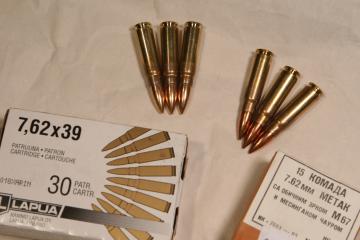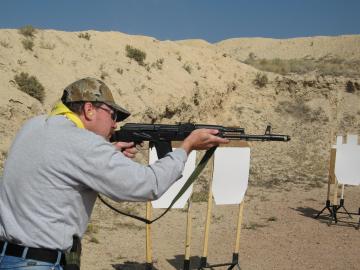
 Surplus military ammunition (right) used to be available for under $100 a
case; now it's over $250 a case, but still cheaper than Lapua factory
ammunition (left).
The wound channel produced by 7.62x39 FMJ ammunition is far from this
ideal. According to tests by Martin L. Fackler, M.D., its wound
channel has an almost ten-inch neck. The bullet yaws and turns around
to a backwards orientation causing a slightly larger internal wound
for another nine to ten inches, and then continues producing a thin
wound channel for another up to ten inches. Compared to the experts'
ideal wound profile, the 7.62x39 fails all criteria.
If we look at the M193 and M855 loadings of 5.56 NATO, they have necks
of approximately four to five inches, maximum damage cavities four to
six inches long and maximum penetration of 12 to 14 inches.
The 7.62x39's terminal ballistics using standard military ammunition
are poor due to low muzzle velocity, the impact velocity is low, which
prevents fragmentation. The bullet construction has no features that
aid bullet expansion or fragmentation. In short, standard military
loadings in 7.62x39 have terminal ballistics similar to small handgun
rounds with non-expanding bullets.
However, the 7.62x39 does have a redeeming quality: it penetrates
intermediate barriers - such as thin metal or a chest-rig of loaded
magazines - better than 5.56 mm. Just as the War On Terror was
getting underway, the U.S. Army Special Operations Command (USASOC)
created the Special Purpose Rifle - Variant (SPR-V) program to fill
the need for a modular assault rifle capable of shooting 5.56 in
addition to 7.62x39 mm. This project was eventually cancelled, but
Special Forces soldiers had come to realize 7.62x39 mm provided
increased lethality over 5.56, especially when penetrating barriers.
The "Enhanced Rifle Cartridge" (ERC) project followed, which created
the 6.8 SPC cartridge; however, that's another story.

 At close range where the AK is most effective, accuracy may not be
critical, but other than on a training range like this one, terminal
effects are critical.
From the drawing board, what can 7.62x39 accomplish? With a case
capacity of only 35.5 grains (the actual "water capacity" of the
case), it has relatively little powder capacity versus its bore size.
For comparison, .308 Winchester has 56 gr water capacity, while .223
Remington has 30.9 gr. Even .30-30 Winchester has 45.0 gr capacity.
If "overbore" cartridges have more than standard case capacity versus
their bore size (such as magnums), the 7.62x39 could be considered
"underbore".
This "underbore" configuration leads to several intrinsic
characteristics. First, ballistics are limited by powder volume.
This means that enough moderate or slow powder cannot fit in the case
to produce proper pressure and high velocity. Faster-burning powder
must be used to produce rifle pressures; however, due to the burn
rate, the velocity of medium and heavy projectiles will be limited.
Second, lightweight projectiles that can be fired at high velocity
will have ballistic coefficient (BC) values too low to retain a
velocity advantage over much distance. For example, if a lightweight
bullet could be shot 300 fps faster than M43, but its BC was half the
M43's FMJ, the 300 fps muzzle advantage would be lost by even 100
yards. Thus, it's pointless to try to gain a lot of muzzle velocity
at the expense of BC with 7.62x39. With modern powders, the
military-standard 2330 fps may be improved by 100 to 130 fps. Third,
7.62x39 will retain performance as the barrel length is reduced.
|